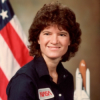Sally Ride

Sally Ride
Sally Kristen Ridewas an American physicist and astronaut. Born in Los Angeles, she joined NASA in 1978 and became the first American woman in space in 1983. She remains the youngest American astronaut to have traveled to space, having done so at the age of 32. After flying twice on the Orbiter Challenger, she left NASA in 1987. She worked for two years at Stanford University's Center for International Security and Arms Control, then at the University of California, San...
NationalityAmerican
ProfessionAstronaut
Date of Birth26 May 1951
CityLos Angeles, CA
CountryUnited States of America
Eventually private enterprise will be able to send people into orbit, but I suspect initially it's going to have to be with NASA's help. Whether it's going to be a consortium or one entity remains to be seen. I could be wrong. I could be one of the old fogies! Rocket science is tough, and rockets have a way of failing. It happens. A company has to be willing to bear the risk of its rocket failing. It's a very large capital investment.
I felt very honored, and I knew that people would be watching very closely, and I felt it was very, very important that I do a good job.
I think eventually private enterprise will be able to send people into orbit, but I suspect initially it's going to have to be with NASA's help.
I've discovered that half the people would love to go into space and there's no need to explain it to them. The other half can't understand and I couldn't explain it to them. If someone doesn't know why, I can't explain it.
I've spent my whole life not talking to people, and I don't see why I should start now.
I have a lot of common sense. I know what needs to be done and how to approach it. I have an ability to work with people on large enterprises.
Three Secrets to Success: Be willing to learn new things. Be able to assimilate new information quickly. Be able to get along with and work with other people.
Women make up only 25 percent of the science, engineering and technology workforce... We are delighted to be working with NASA Ames to give Silicon Valley area girls a chance to explore and develop their potential in science at an age when many begin to drift away from their natural interest.
My parents didn't have a scientific bone in their body, and their daughter was pursuing a career in astrophysics. They didn't even know what astrophysics meant, but they supported me,
There are aspects of being the first woman in space that I'm not going to enjoy.
The women's movement had already paved the way, I think, for my coming.
Today, the astronaut corps is almost 25% female, ... and I want that to continue to rise.
If girls are interested, they have the potential to go further, ... There are still lingering stereotypes that affect girls in middle school, and they lose interest in the subjects.
It was hard to become an astronaut. Not anywhere near as much physical training as people imagine, but a lot of mental training, a lot of learning. You have to learn everything there is to know about the Space Shuttle and everything you are going to be doing, and everything you need to know if something goes wrong, and then once you have learned it all, you have to practice, practice, practice, practice, practice, practice, practice until everything is second nature, so it's a very, very difficult training, and it takes years.